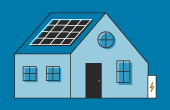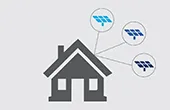Scientists are always looking for ways to make solar as efficient, accessible, and aesthetically pleasing as possible. Some of the most exciting research and development taking place in the industry today revolves around constructing thin, flexible solar options using organic solar cells.
Continue readingComparing quotes: why are installers proposing different system sizes?
So you have a few quotes, sit down to evaluate them, and notice something right off the bat: installer A and installer B have proposed different sizes for your solar panel system. Why is this? And how can you truly compare apples-to-apples in this scenario?
In this article, we’ll review why this might happen – and what you can do about it!
Continue readingLithium mining in the United States: an industry in Nevada
Lithium, the lightest element of all the metals, is a crucial resource for the United States’ clean energy future: it’s key in the production of lithium ion rechargeable batteries, which are used to power electric vehicles and serve as home storage systems. While the U.S. is the largest consumer of lithium and will only increase its future consumption as it strives to meet the Biden Administration’s ambitious greenhouse gas emission targets, America’ domestic mining of lithium is limited to just one percent of annual global production.
Currently, only one lithium mine operates in the United States, the Silver Peak mine in Clayton Valley, Nevada; most of the global lithium supply is extracted in Chile and Australia. While some politicians are calling for increased domestic mining of the metal, at the end of May 2021, Reuters reported that the Biden Administration would supply the majority of lithium from ally countries, including Canada, Australia, and Brazil. Though this strategy may seem antithetical to the Administration’s clean energy jobs goals, it comes on the heels of many environmentalists’ concerns over two potential lithium mines in Nevada that could become operational in a few years. In this article, we’ll break down lithium mining and why these two mines are so controversial.
Continue readingHow to find affordable solar panels
Installing a solar energy system is becoming increasingly attainable for homeowners across the country as prices continue to drop. Being savvy about where to find the best deals on solar can make your solar installation process pain-free, and lead to maximum savings.
Continue readingUnderstanding time-of-use (TOU) rates
Across the country, utilities are beginning to introduce innovative rate structures for residential energy consumers. These rate structures–from time-of-use rates to demand charges to real-time-pricing–all have a common goal: to incentivize customers to consume energy during times when the cost of generating electricity is cheap, and to disincentive energy consumption when the cost of generating electricity is high. As a result, understanding the ins and outs of a time-of-use rate can help you reduce your monthly cost of energy.
Continue readingWhere is solar energy used?
Solar energy is expanding worldwide and becoming an increasingly important part of the energy mix in many countries. We consulted several reports to determine which countries use the most solar energy and which parts of the world have the highest solar production capabilities.
Continue readingSolar loans: what you need to know
Want to finance your solar panel installation? Cash purchases and solar leases (or PPAs) aren’t your only options. If you don’t have–or aren’t willing to spend–the capital for a cash purchase but want to maximize the financial benefits of a solar energy system, the solar loan offers the best of both worlds.
Continue readingLumeta Solar: stick-on solar panels
There are many property owners who hesitate in installing solar because of how the panels will look on their roof, or because they worry about possibly damaging their roof during installation. With this in mind, Lumeta Solar sought to create a product that sticks flat against your roof, while not requiring roof penetrations for installation: adhesive solar panels.
Continue readingMiaSolé thin film flexible solar panels: a silicon PV alternative for your roof
Most of the solar panels that are installed in the United States are made of silicon photovoltaic (PV) cells, but silicon PV doesn’t work for every situation. Thin film solar panels are an alternative that’s starting to take hold, particularly in situations where rigid PV panels aren’t an option.
Continue readingSRECs: understanding solar renewable energy credits
Of all the incentives for installing solar panel systems, solar renewable energy certificates (SRECs) are some of the most beneficial, yet most complicated to understand. However, SRECs can provide sizable income to owners of solar power systems that live in eligible markets.
Continue reading




